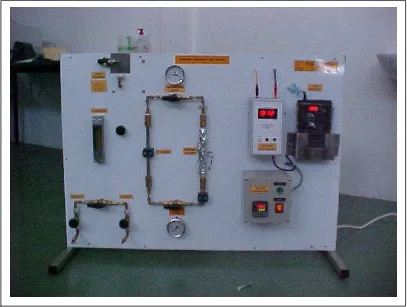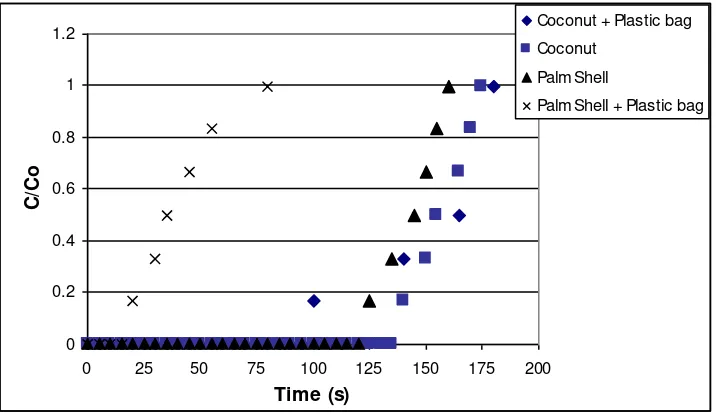CARBON ADSORBENT PREPARED FROM WASTE MATERIALS
FOR LPG GAS STORAGE MEDIA
Safarudin Gazali Herawan
1, Imran Syakir bin Mohamad
1, Mohd Haizal bin Mohd Husin
1,
Ahmad Anas bin Yusof
1, Ernie Mat Tokit
1, Imanurezeki Mohamad
1, and Farid Nasir bin Hj Ani
21Kolej Universiti Teknikal Kebangsaan Malaysia, Locked Bag 1200, Ayer Keroh, 75450 Melaka, Malaysia Email: safarudin@kutkm.edu.my
2Faculty of Mechanical Engineering, Universiti Teknologi Malaysia, 81310 UTM, Skudai, Johor, Malaysia
ABSTRACT
Coconut shell and oil palm shell are an agricultural waste material found abundantly in Malaysia. Since the characteristics of coconut shell and oil palm shell were found suitable for preparing activated carbon, these materials also have the potential to be prepared into useful and valuable product. This research, the concern is to make use of coconut shell or oil palm shell which it mixed with plastic bag to prepare the carbon adsorbent, which applied for hydrocarbon gas storage. This sample was prepared at a laboratory scale fixed-bed reactor, which is blanketed by a vertical furnace where pyrolysis took place. Nitrogen gas was used to obtain an inert atmosphere in the reactor. A suction blower was used to remove volatile matter as well as other gases during carbonization process. The samples were prepared in the different peak temperature and amount of the plastic bag which it mixed with them. CO2 activation also was used
to investigate the effect of it in the sample. This research work will attempt to find a suitable solution to solve the environmental problems by utilizing the waste materials and to look into the industrial aspect of adsorption process for gas storage.
Keywords: Gas Storage; Carbon Adsorbent; Waste Material
1.0 INTRODUCTION
Carbon adsorbent is a type of carbon produced through exposing a source material such as wood or bone to very high temperatures in the presence of steam, air, or carbon monoxide. Activated carbon is very good at removing or adsorbing contaminants and is used in water filters, to decolor solutions, and is sometimes administered to poisoning victims.
The waste materials that are mixed of coconut shell or palm shell and plastic bag are found in large quantities will be used as a carbon adsorbent. Carbon adsorbent has been shown to be applicable for treatment of a wide variety of environmental contaminants. When properly applied, the adsorption process will remove pollutants for which it is designed (Shepherd, A., 2001).
Shepherd, A.(2001) also stated that the activated carbon will function as a carbon adsorption where the contaminated gas will be attracted to and accumulated on its surface. In evaluating the effectiveness of the carbon adsorption by using the waste material, the characteristics of the application will be considered first. This will help in obtaining a strong adsorption. In this case, the researcher will take into consideration where the molecules of a contaminant tend to adsorb most strongly in areas where the pore diameter of the adsorbent is close to the molecular diameter of the compound.
The importance of its role has been looked as a demolition of a clean environment. With these characteristics, studies will be carried out to investigate its adsorption capacity as a fuel carbon adsorbent that is applicable for hydrocarbon gas storage that is widely used in the automotive area (Burchell, 1995).
For example, utilizing the activated carbon in controlling pollutants emissions in natural gas storage tank (Robinson), Liquefied Petroleum Gas (LPG) and Gasoline storage tank (Air Resources Board, 1997) and Proton-Exchange Membrane (PEM) Fuel Cell Vehicle (James, 1996).
been going on since the early 1980s. Robinson stated that the Absorbed natural gas (ANG) is an interesting alternative to Compressed Natural Gas (CNG) since the same amount of natural gas can be stored at much lower pressure (500 psi or 30 atm) in a thinner walled tank filled with activated carbon and this provides more energy than gasoline on a weight basis.
2.0 LIQUEFIED PETROLEUM GAS (LPG)
LPG is a natural occurring and refined hydrocarbon which is most often stored as a liquid under pressure. It is usually transported in bulk and pressurized vessels. It is a naturally occurring material and is also produced through the refining process for other hydrocarbon such as petrol and diesel (Calor Gas).
Researchers used LPG in application of alternative vehicle fuel, which have benefits include total elimination of smoke and virtual elimination of smell. It also contributes to a much quieter and smoother running engine. As well as the environmental benefits, compared to other alternative fuels LPG combines high performance with economy, making it the best current alternative to petrol or diesel fuels (Calor Gas).
Carbon adsorbent as a gas storage media for LPG is an alternative way to overcome the disadvantages of pressurized vessel such as high pressure flammable gas content, dimension of gas tank, and other dangerous aspects.
3.0 METHODOLOGY
This research has been conducted by designing and developing the experimental rig for preparing carbon adsorbent, which are consisted of a reactor, tube furnace, suction blower and some accessories as a first stage. At the same time, the carbon adsorbent test bed is designed and developed, which has a column adsorber for carbon adsorbent and is connected online with a Gas Detector to determine the breakthrough curves for LPG that can lead to determine adsorption selectivity for LPG.
Next stage is preparing carbon adsorbent from waste material such as coconut shell or oil palm shell and mixed with plastic bag using the experimental rig, which is processed by conventional method using pyrolysis technique. By varies the peak temperature of the sample, the optimization of it can be achieved. This process is carried out in a laboratory scale, fixed bed reactor, which blanketed by tube furnace where the pyrolysis take place. Nitrogen gas is used to obtain an inert atmosphere in the reactor and CO2 gas is
Fig. 1. The Experimental rig for producing carbon adsorbent
For application purpose, carbon adsorbent test bed has been developed as shown in fig. 2. It is clear that the apparatus consists of two column (empty column and carbon adsorbent bed, which is blanketed with heating tape), temperature control for heating the sample due to desorption process, timer for calculating the adsorption time up to saturated condition, and gas detector in %Gas to detect the flue gas after exposes to the sample. The breakthrough curve can be used to obtain the data on the capacity and selectivity of the adsorption happened. The experiment will stop when the curves show the breakthrough (inlet =outlet concentration) for LPG at 5 ml/min of feeding.
Fig. 2. Carbon adsorbent test bed
3.1 Preparation of Carbon Adsorbent
The waste materials as a raw material are oil palm shell, coconut shell, and plastic bag. Oil palm shell or coconut shell were crushed and sieved to a size of 250 – 425 m separately. About 50 grams of each formed particles were fed in the reactor. The char was prepared at 10oC/min of the heating rate, up to 600oC, 700oC, and 800oC and was maintained for 60 minutes in 1.5 l/min of N2 (99.98% of purity from
Linde) flow.
Both chars prepared at the peak temperature of 700oC were mixed with 10%wt of plastic bag. The aim of this method is to observe the effect of plastic bag in the char due to adsorption capacity of LPG. The mixed char then was placed in the same reactor and heated at 10oC/min of the heating rate, up to 700oC in the 200 ml/min of N2 flow and was maintained for 60 minutes, and then N2 was switched off and changed
to CO2 flow at 162 ml/min for 30 minutes.
4.0 RESULTS AND DISCUSSION
increasing peak temperature actually can shrink the pore structure of char (Safarudin, 2000), therefore the smaller pore structure of char is not suitable for adsorbing LPG.
Fig. 3. Time to reach Co for chars of oil palm shell and coconut shell at varies peak temperature
However, the adsorption of LPG at coconut shell char dramatically decreases from 700oC to 800oC as comparison with oil palm shell char. It might be concluded that the adsorption of LPG do not appropriate with higher peak temperature for coconut shell char especially and both of them generally.
Fig. 4. Breakthrough curve vs time for oil palm shell and coconut shell char, and both chars mixed with plastic bag.
The breakthrough curves for these four carbon adsorbents are displayed in Fig. 4, which shows the breakthrough curves of carbon adsorbents that are subjected to LPG. As shown in this figure, coconut shell char adsorbs more LPG than oil palm shell char. The plastic bag indeed effect the both chars unfortunately in different results. The plastic bag in coconut shell char can increase the adsorption of LPG, however in case of mixed oil palm shell char; the adsorption of LPG dramatically decreases. This could be happened due to the pore structure of carbon adsorbent (Safarudin, 2000).
The average pore diameter of coconut shell char is bigger than oil palm shell at the same procedure of preparation (Safarudin, 2000) therefore the smaller pore size can reduce the capability to adsorb LPG. The plastic bag might block or shrink the pore structure of the char. For oil palm shell char, this effect results the reduction of LPG adsorption. Somehow, the existing of plastic bag in coconut shell char dedicates appropriate condition that can result the increasing capability for adsorbing LPG.
5.0 CONCLUSION
Waste material (coconut shell, oil palm shell, and plastic bag) can be used for producing carbon adsorbent for LPG gas storage media since all the samples show capability to adsorb LPG, unfortunately the capacity is still low. However, this research are still continue to explore more finding to achieve a better results. It is found that coconut shell mixed with plastic bag shows a higher capability to adsorb LPG than the other samples.
6.0 ACKNOWLEDGMENT
The authors acknowledge the short-term research grand provided by Ministry of Education that has resulted in this paper.
7.0 REFERENCES
1. Air Resources Board. Motor vehicle LPG test program,
http://www.ard.ca.gov/fuels/altfuels/lpg/mvlpge/mvlpge.htm (accessed September 2003) (1997).
2. Burchell, Tim. Carbon materials for advances technologies,
http://www.americancarbonsociety.org/CMATbook.html (accessed July 2003) (1995).
3. Calor Gas Home Page, http://www.calorgas.ie/ (accessed October 2003).
4. CATF Review Newsletter. New promise for adsorbents in gaseous fuel storage.
http://catf.bcresearch.com/catf/review/issue_20/promise.htm (accessed August 2003) (1995).
5. James, Brian D., Baum, George N., Lomax, Franklin D., Jr., Thomas, C.E. (Sandy), and Kuhn, Ira F., Jr. Comparison of Onboard Hydrogen Storage for Fuel Cell Vehicles. Ford Motor Company (1996).
6. Robinson, Ken, Mieville, Rodney L., Jasionowski, Walter J., and Butt, John B. Natural gas storage with bonded carbon, http://www.megacarbon.com/techlit/Ang.html (accessed August 2003).
7. Safarudin Gazali Herawan. Characterisation and Analysis of Carbon Molecular Sieve from Oil Palm Shell. Master of Mech Eng. Thesis, Universiti Teknologi Malaysia (2000).

